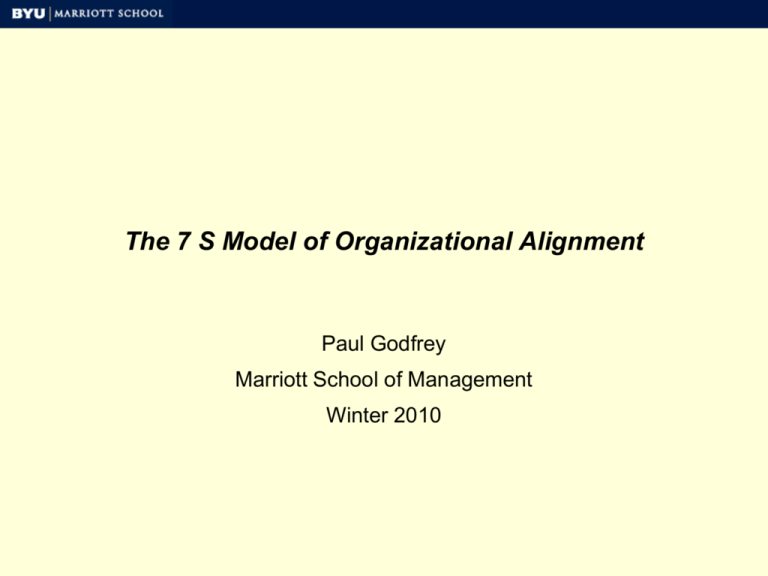7 S Analysis: A How To Primer
advertisement

The 7 S Model of Organizational Alignment Paul Godfrey Marriott School of Management Winter 2010 The 7 S Model The 7 S model helps describe organizational reality • A set of buckets to sort information The 7 S’s as a balloon • Push on one side, the other sides all move • The 7 S’s constitute a system Two components: • The Hard Triangle: Strategy, Systems, Structure • The Soft Square: Staffing, Skills, Style, Shared Values The 7 S Model Strategy Structure Systems Shared Values Staffing Skills Style Strategy •Organizational Goals •Competitive Advantages Structure Systems •Division of Labor •Reporting responsibilities •Coordination •Control Shared Values •Common Belief •Priorities Staffing Skills •Hiring, Training, Promoting •Technologies •What we do well Style •Interpersonal relationships The Positives Strategy •Full Service •Regional Coverage •Focused on Core •Long Term View Structure Systems •Decentralized •Functional Expertise •Geographic Focus •Tight Cost Control •Bonus Incentives •Merit Promotion Shared Values •Conservative •Profitability •Loyalty •Decentralization •Equity & Generosity Staffing Skills •Hire good people •MDP •Promote from within •Customer Service •Cost Control Style •Informal •Friendly •Practical The Negatives Strategy •No focus on niches •No operating synergies •Few strategic assets Structure Systems •Management by exception •Functional Silos with little communication •Excessive Internal Focus •Little incentive pay •Promotion on Seniority Shared Values •Comfortable •Complacency •Excessive Frugality Staffing Skills •Hire by W.O.M. •Little Training •Hard to Fire •“We know what customers want” •Reliance on traditional ways Style •Non-confrontational •Little Challenge & debate •Slow to decide Expanding the 7 S Model • Super-ordinate goals: What is the organization trying to accomplish? • Situation/ Stakeholders: What is the overall environment the organization faces? • Self: What is the role of the change agent in the model? The Expanded 7 S Model Super-ordinate Goals Strategy Structure Self Systems Shared Values Staffing Skills Style Situation/ Stakeholders Advantages of the expanded model • Adding super-ordinate goals brings out more clarity – Strategic objectives (market share) vs. strategy tools (differentiation) – Goals as a reflection (manifestation) of shared values – Goals can shift, causing misalignment • Adding the Situation/ Stakeholders “places” the organization – In both competitive space and time – Most misalignments begin with changes in this area and ripple through the system • Adding the self focuses on the role of individuals to impact the system











